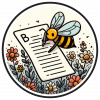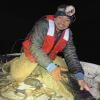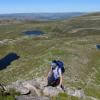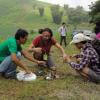With new technologies revolutionizing data collection, wildlife researchers are becoming increasingly able to collect data at much higher volumes than ever before. Now we are facing the challenges of putting this information to use, bringing the science of big data into the conservation arena. With the help of machine learning tools, this area holds immense potential for conservation practices. The applications range from online trafficking alerts to species-specific early warning systems to efficient movement and biodiversity monitoring and beyond.
However, the process of building effective machine learning tools depends upon large amounts of standardized training data, and conservationists currently lack an established system for standardization. How to best develop such a system and incentivize data sharing are questions at the forefront of this work. There are currently multiple AI-based conservation initiatives, including Wildlife Insights and WildBook, that are pioneering applications on this front.
This group is the perfect place to ask all your AI-related questions, no matter your skill level or previous familiarity! You'll find resources, meet other members with similar questions and experts who can answer them, and engage in exciting collaborative opportunities together.
Just getting started with AI in conservation? Check out our introduction tutorial, How Do I Train My First Machine Learning Model? with Daniel Situnayake, and our Virtual Meetup on Big Data. If you're coming from the more technical side of AI/ML, Sara Beery runs an AI for Conservation slack channel that might be of interest. Message her for an invite.
Header Image: Dr Claire Burke / @CBurkeSci

Explore the Basics: AI
Understanding the possibilities for incorporating new technology into your work can feel overwhelming. With so many tools available, so many resources to keep up with, and so many innovative projects happening around the world and in our community, it's easy to lose sight of how and why these new technologies matter, and how they can be practically applied to your projects.
Machine learning has huge potential in conservation tech, and its applications are growing every day! But the tradeoff of that potential is a big learning curve - or so it seems to those starting out with this powerful tool!
To help you explore the potential of AI (and prepare for some of our upcoming AI-themed events!), we've compiled simple, key resources, conversations, and videos to highlight the possibilities:
Three Resources for Beginners:
- Everything I know about Machine Learning and Camera Traps, Dan Morris | Resource library, camera traps, machine learning
- Using Computer Vision to Protect Endangered Species, Kasim Rafiq | Machine learning, data analysis, big cats
- Resource: WildID | WildID
Three Forum Threads for Beginners:
- I made an open-source tool to help you sort camera trap images | Petar Gyurov, Camera Traps
- Batch / Automated Cloud Processing | Chris Nicolas, Acoustic Monitoring
- Looking for help with camera trapping for Jaguars: Software for species ID and database building | Carmina Gutierrez, AI for Conservation
Three Tutorials for Beginners:
- How do I get started using machine learning for my camera traps? | Sara Beery, Tech Tutors
- How do I train my first machine learning model? | Daniel Situnayake, Tech Tutors
- Big Data in Conservation | Dave Thau, Dan Morris, Sarah Davidson, Virtual Meetups
Want to know more about AI, or have your specific machine learning questions answered by experts in the WILDLABS community? Make sure you join the conversation in our AI for Conservation group!
- @bluevalhalla
- | he/him
BearID Project & Arm
Developing AI and IoT for wildlife



- 0 Resources
- 32 Discussions
- 6 Groups
- @hjayanto
- | He/Him
KONKLUSI (Kolaborasi Inklusi Konservasi - Yayasan)
Your friendly Indo-Crocky-Croc



- 0 Resources
- 36 Discussions
- 17 Groups
Wildlife Protection Solutions (WPS)
- 0 Resources
- 0 Discussions
- 4 Groups
Ocean Science Analytics
Marine mammal ecologist and online technical trainer



- 1 Resources
- 32 Discussions
- 6 Groups
- @StephODonnell
- | She / Her
WILDLABS & Fauna & Flora
I'm the Executive Manager at WILDLABS.



- 153 Resources
- 669 Discussions
- 30 Groups
- @Dominik
- | He/Him
PhD Student on bio- and ecoacoustics at the University of Freiburg (GER)
- 0 Resources
- 1 Discussions
- 2 Groups
I am nature lover and now lost the tolerance to just be an admirer watching its destruction. Hence joining this crew to contribute my supportive work much lesser than a penny worth
- 0 Resources
- 0 Discussions
- 3 Groups
- @capreolus
- | he/him
Capreolus e.U.
wildlife biologist with capreolus.at





- 1 Resources
- 73 Discussions
- 16 Groups
- @ryanhuang
- | He/Him/His
Conservation scientist based in Pretoria, South Africa
- 0 Resources
- 0 Discussions
- 6 Groups
- @jsstamn
- | She/her
PhD student at the University of Mississippi; research interests include predator/prey dynamics, particularly the landscape of fear in relation to species conservation. Rookie at using arduino
- 0 Resources
- 3 Discussions
- 5 Groups
- @Rob_Appleby
- | He/him
Wild Spy
Whilst I love everything about WILDLABS and the conservation tech community I am mostly here for the badges!!





- 1 Resources
- 266 Discussions
- 11 Groups
Msc student in wildlife management and conservation


- 0 Resources
- 1 Discussions
- 11 Groups
Vote for your favorite submissions that best demonstrate conservation impact, novel innovation/discovery, and strong storytelling of the work and the sector.
12 August 2024
Climate Change AI calls for applications for Innovation Grants regarding AI/ML research projects. Eligible applicants are principal investigators at accredited universities in OECD member countries.
12 August 2024
To celebrate our 9th Annual #Tech4Wildlife Photo Challenge happening this week, we’re taking a look at past and current submissions that feature the fastest growing areas of conservation tech: movement ecology, AI,...
7 August 2024
WILDLABS is thrilled to announce the launch of a Horizon Scan on emerging priorities in Bioacoustics, supported by the Moore Foundation and in collaboration with Colorado State University. This project aims to identify...
5 August 2024
We are recruiting an (extendable) 2-year postdoc in my group to develop new technologies (cameras, microphones, deep learning, etc) to track earthworm activity in the field.
16 July 2024
The Reversing Environmental Degradation in Africa and Asia (REDAA) Programme is seeking a consultant to look into current issues with AI to develop a better shared understanding of how AI and related technologies could...
11 July 2024
Aerial seeding with drones has great potential in forest restoration but faces enormous challenges to be efficient and scalable. Current protocols use blanket seeding throughout the area to be restored, meaning a high...
20 June 2024
Come join us at AIMS, and work on deep learning for bioacoustics research!
14 June 2024
The AI for Climate and Nature Grand Challenge initiative from the Bezos Earth Fund has opened a call for proposals for "exploring new ideas for multiplying the impact of climate and nature efforts using modern AI"
12 June 2024
The San Diego Zoo Wildlife Alliance's Burrowing Owl Recovery Program and Conservation Technology Lab seek a postdoctoral research associate to develop bioacoustic tools for monitoring the western burrowing owl...
11 June 2024
Come and do the first research into responsible AI for biodiversity monitoring, developing ways to ensure these AIs are safe, unbiased and accountable.
11 June 2024
August 2024
event
September 2024
event
event
event
October 2024
November 2024
August 2024
event
July 2024
June 2024
61 Products
Recently updated products
15 Products
Recently updated products
| Description | Activity | Replies | Groups | Updated |
|---|---|---|---|---|
| Thanks, I grabbed those datasets already. I know about that website, put couldn't quite make sense of it. It says 'open repository', but then there is a login page with no way to... |
|
AI for Conservation, Open Source Solutions, Protected Area Management Tools, Drones, Remote Sensing & GIS | 1 day 14 hours ago | |
| Hey @Sylvain_H Am leaning towards Maad Audiophiles or The Maad Eco Community |
+5
|
Acoustics, AI for Conservation, Open Source Solutions, Software and Mobile Apps | 2 days 16 hours ago | |
| @DibblexLesalon looks like a great question for your team at Expert Drones Africa :) |
|
AI for Conservation | 4 days 11 hours ago | |
| However, I think it's important to reflect further to determine exactly what needs to be done. |
+8
|
Climate Change, AI for Conservation, Biologging, Citizen Science | 1 week ago | |
| Congrats on the publication! Great work! |
|
AI for Conservation | 6 days 17 hours ago | |
| The German start-up Dryad is also working on early fire detection using sensors and AI. |
|
AI for Conservation | 6 days 20 hours ago | |
| Hey, You're correct, traditionally species distribution models are spatial only, but here are a few ideas for how to incorporate time into your modelling: Categorise the... |
|
AI for Conservation | 1 week 2 days ago | |
| I found this interesting |
+48
|
AI for Conservation, Emerging Tech | 1 week 4 days ago | |
| hi, if your intention is to use programming and a programming language like Python then one option which can give good results is the SAM (Segment Anything) or SAM-2 algorithm.... |
|
Data management and processing tools, AI for Conservation | 1 week 3 days ago | |
| Really interesting, I will take a look |
|
AI for Conservation, Camera Traps, Data management and processing tools, Emerging Tech | 1 week 6 days ago | |
| Great new!! |
+15
|
AI for Conservation | 1 week 6 days ago | |
| Hi Carly, thank you for the advice! I am only focusing on the two birds for now - my goal is to use part of the iNaturalist data I have pulled to train the model and the rest to... |
|
AI for Conservation | 1 week 6 days ago |
Two-year Postdoc (extendable) in AI and Remote Sensing to Monitor Earthworms in the Field
16 July 2024 9:02am
REDAA is hiring a consultant to explore AI - DEADLINE EXTENDED
11 July 2024 12:33pm
ForestSAT
5 July 2024 7:04pm
Question About Interpolation
18 June 2024 10:52pm
Workflow for automated precise seeding with drones and artificial intelligence
20 June 2024 12:22pm
FOSS Geospatial Tools
Deep learning & bioacoustics postdoc in Cape Town, South Africa
14 June 2024 1:52pm
Conservation Technology for Human-Wildlife Conflict in Non-Protected Areas: Advice on Generating Evidence
22 January 2024 11:36pm
4 February 2024 8:16am
Hi Amit,
The most important thing is that the livestock owners contact you as soon as possible after finding the carcass. We commonly do two things if they contact us on the same day or just after the livestock was killed:
- Use CyberTracker (or similar software) on an Android smart phone to record all tracks, bite marks, feeding pattern and any other relevant signs of the reason for the loss with pictures and GPS coordinates. [BTW, Compensation is a big issue -- What do you do if the livestock was stolen? What do you do if a domestic animal killed the livestock? What if it died from disease or natural causes and was scavenged upon by carnivores afterwards?]
- In the case of most cats, they would hide the prey (or just mark it by covering it with grass or branches and urinating in the area). In this case you can put up a camera trap on the carcass to capture the animal when it returns to its kill (Reconyx is good if you can afford it - we use mostly Cuddeback with white flash). This will normally only work if the carcass is fresh (so other predators would not be able to smell it and not know where it is yet), so the camera only has to be up for 3-5 days max.
This is not really high-tech, but can be very useful to not only establish which predator was responsible (or if a predator was responsible), but also to record all the evidence for that.
13 June 2024 8:58pm
Hey Amit,
This is a great question; from our work, we've seen people do a couple of things. We've even seen people using Ring doorbell footage in urban areas as evidence.
The best thing we've seen is matching the community needs with existing infrastructure:
- Are there existing cameras you can leverage, like the doorbell cameras?
- Can public participation monitoring service this, i.e. public submitted photos and videos?
It also totally depends on the wildlife species you're working with, the interaction, damages, etc. If you've found any good solutions, let me know. I'd love to share that information with our clients here who have constant bear problems.
14 June 2024 9:09am
In that case, you might want to keep an eye on the project from @Lars_Holst_Hansen
Bezos Earth Fund, AI for Climate and Nature Grand Challenge call for $50K-2M projects
12 June 2024 2:58pm
Postdoctoral Research Associate: Bioacoustics & population modeling
11 June 2024 9:35pm
Fully funded PhD in AI biodiversity monitoring
11 June 2024 1:07pm
AI Identification Models on Thermal Data
6 June 2024 8:30pm
7 June 2024 4:06am
Wow! This dataset seems great and definitely worth trying out. Do you perhaps have a dataset for deer, elk, and those animals of the sort?
I live in the mountainous region so deer are very common and easily hit.
Thank you again
7 June 2024 5:43pm
Sorry, the only other dataset of thermal camera trap images that I'm aware of is mostly elephants, although it does have some goats:
https://github.com/arribada/human-wildlife-conflict?tab=readme-ov-file#elephant-dataset
7 June 2024 7:28pm
No worries! I'll be trying the other one to see how it works. Thank you for your help!
VIHAR-2024 deadline extension, June 30th (Interspeech satellite event)
5 June 2024 10:30am
5 June 2024 3:05pm
Thanks for sharing this @nkundiushuti ! I think this post would be better suited as an event, that way it will show up on the WILDLABS event calendar page. Let me know if you have any questions on how to make an event post! You just click the +Post button in the top right corner, then click "event."
7 June 2024 8:29am
hi Alex!! I already posted the event, I just wanted to posted an update: the deadline was extended.
7 June 2024 1:45pm
Fantastic!!
€4,000 travel grants for insect monitoring an AI
6 June 2024 4:49pm
Has anyone combined flying drone surveys with AI for counting wild herds?
14 April 2024 3:40pm
27 May 2024 10:55am
Actually my Raspberry Pi application is a sound localizer not related to image recognition. My image recognition related project runs on Jetsons and higher.
But I think recognizing bugs on a drone would likely be challenging. You would have to have sufficient detail to get good recognition which would be a very narrow field of view and then vibration also becomes an issue.
For example, the trainings on just the coco dataset seems to distill the recognition of people to a multi-segmented thing with bits sticking out. So spiders on camera lens are highly likely to be seen as people. To get better results much more training data is needed. I expect it's also likely to be the case for insects, really large amounts of training data would be needed to tell the difference between different types.
31 May 2024 5:47pm
Hi Johnathan,
There is a Canadian company more or less doing that. They have their own endurance drone and optical/thermal cameras. Very much keyed into surveys and they may have success given the number of helicopter accidents we have had in Western Canada. Not sure if the AI part is there yet.
I know they've done surveys with at least one department here but not much beyond that. I talked to one of the developers their just as a point of interest. The current leadership today looks different than I remember though.
6 June 2024 2:48pm
The camera can be aimed at the greenhouse background, which is like a huge green screen. Inside the greenhouse there's only a few flying insects, and they would all have to fly between the optics and the wall or roof eventually. Or if the bot is flying, have it look upwards.
It's pretty much a programing question. Unfortunately I am not the type of person who is good at both building and troubleshooting hardware, and writing code. I took some programming back in college but I am not sure if I want to get myself up to speed. It's starting to sound like I need a few years of college before I can even get started. Which I already did, too bad none of it counts for anything anymore. Or I guess I can compete in the marketplace with people with real money behind them, which is the only thing that means anything. If you are brilliant and not funded, you might as well be a scarecrow.
New WILDLABS Funding & Finance group
5 June 2024 3:24pm
5 June 2024 4:14pm
6 June 2024 1:38am
6 June 2024 4:16am
Apply! 2024 Conservation Tech Award
3 June 2024 3:51pm
Recruiting for a paid study on Explainable AI & bird identification
1 June 2024 8:34pm
Announcing: BeetlePalooza 2024
31 May 2024 9:00pm
🌟 Seeking a Mentor in Software Engineering 🌟
30 May 2024 10:46am
Bioacoustics and AI 101
29 May 2024 2:21pm
9th Workshop On Detection and Classification of Acoustic Scenes and Events
28 May 2024 8:57pm
32nd European Signal Processing Conference
28 May 2024 8:44pm
5th World Ecoacoustics Congress
28 May 2024 8:07pm
Computational Entomology Webinar III: Processing liquid samples
22 May 2024 12:40am
DeepDive: estimating global biodiversity patterns through time using deep learning
20 May 2024 4:51pm
These authors "develop an approach based on stochastic simulations of biodiversity and a deep learning model to infer richness at global or regional scales through time while incorporating spatial, temporal and taxonomic sampling variation."
4th International Workshop onCamera Traps, AI, and Ecology
9 May 2024 1:00pm
Harnessing large language models for coding, teaching and inclusion to empower research in ecology and evolution
9 May 2024 12:51pm
Check out this paper that reviews the current state of AI in conservation.








































































28 June 2024 6:35pm
The use of synthetic training data such as interpolated sequence values is common, but fraught with the issue of your synthetic signal generating features that are not true to real life.
Instead, you might think about about appending the values of two long-period sin waves per input element to the sequence going in to your first linear / fully-connected layer. The simplest thing that could possibly work would be to interpret minute of the day and day of the month as the values of your sin wave! (Or perhaps minute/hour if all training sequences are quite short.) Since you’re doing sequence prediction, you would add the appropriate values for each image(?) in the sequence being evaluated.
With that additional signal going in to the model in the early layers, the NN should have a good chance of learning that the differences in the modulating signal corresponds to distance in time.
This technigue was popularized by early Large Language Models to encode the distance between words. There’s been refinement (search “Rotary Encoding” for instance) but the basic idea of sin waves generalizes well.